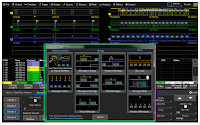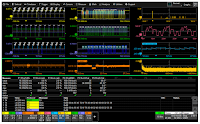 |
| Figure 1: Serial-data links handle traffic between ICs and peripheral devices in the IoT world |
Here are brief summaries of these three serial-data standards:
- I2C: The Inter-Integrated Circuit protocol serves short-distance communication between peripheral ICs and processors.
- SPI: Known as Serial Peripheral Interface, this standard is used for short-distance communication in embedded systems.
- UART: The Universal Asynchronous Receiver Transmitter protocol applies to device serial-port communication.
 |
| Figure 2: Shown are all three serial data standards captured simultaneously |
 |
| Figure 3: The dialog box at bottom makes it easy to set up for protocols |
What can one acquire from a serial bit stream? Basically, anything of interest, as can be seen from Figure 3. In this example, the oscilloscope was set to trigger on I2C address 30. In the acquisition trace at top, note that the ID 30 is highlighted in red just to the left of the trigger point. The decode table at left shows the I2C message highlighted in yellow in the midst of a series of SPI messages. The ability to time-correlate these various bus events helps in determining cause-and-effect relationships between activities in different serial-data protocols.
 |
| Figure 4: This snapshot shows a number of tools useful for serial-data debug |
 |
| Figure 5: Statistical data reveals a great deal about bus activity |
Equally valuable are the oscilloscope's statistical capabilities. The green-outlined area at lower left of Figure 5 shows us the statistical data on the various parameter measurements being made, and underneath each column of statistics is a histogram displaying the distribution of the measurement. The screen capture shows that over 28,000 measurements of message bit rate had been made. The histogram shows peaks in the distribution at the high and low ends, a nearly sinusoidal shape. This could indicate an issue that would merit investigation.
 |
| Figure 6: An FFT of the DC power rail helps unravel issues in the DC power level |
As we're conducting our investigation of the serial buses, we might also want to see what's going on with the DC power rails. Figure 6 adds those acquisitions in the green-outlined area. We can see little notches appearing in the orange waveform that should be a flat DC level. At right is a frequency-domain look at the same signal, where we can examine the frequency content of those notched areas.
Our next post will look at debug of CAN bus in IoT devices.
Previous blogs in this series:
Debugging the IoT
Anatomy of an IoT Device
IoT Digital Power Management and Power Integrity
Investigating IoT Wireless Signals
Investigating IoT Wireless Signals (Part II)
Acquiring and Characterizing IoT Sensor Signals
No comments:
Post a Comment